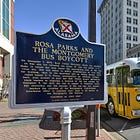Momentum
Explore the throughline in mass transit ballot initiatives and key social change models.
Route 24 is your civic education stop for stories driving public trust.
DRIVERS ED parks in your inbox on Tuesdays to shift your gears on key policy debates and test drive people-powered solutions.
Note: Route 24’s Toolkit and About Page are in the process of being updated to meet the moment. In the interim, stop by some of our recent posts:
Push-to-Walk
According to the American Public Transportation Association, ballot measures across the country favoring public transit had an 86.7% success rate at the polls across General, Primary and Special Elections. In 2024, that represented a total of 46 ballot measure wins out of 53 proposed mass transit ballot initiatives, signaling that the majority of the American public, regardless of partisan positioning, voted for affordable, publicly accessible, and sustainable transportation infrastructure. This includes route maintenance and repair, service hour and frequency expansion, new line and connection creation to reduce congestion, accessibility considerations, and tax levies. In line with this data, such ballot measures generate $25 billion nationally in estimated revenue for public transit operations and improvements.
At first glance, this data reaffirmed much of my assumptions about voter preferences this election cycle: across cultural and geographical borders, there was an unyielding priority placed on affordability. I saw this on the ground when volunteering in battleground states this year and when working as a community organizer on a municipal campaign in 2020. Across party lines, reliable access to transportation was an issue every citizen cared about. Upon reflection, however, I started to wonder: what made transportation different than other hot-button election issues? The answer wasn’t immediately clear. The economy, environment, and identity politics were all deeply intertwined within public transit narratives, and yet, in terms of voter turnout, community-driven solutions won over a push towards privatization. Why hadn’t this national trend applied to the presidential outcome? Last week, I spoke about a recent battleground state civility poll from Georgetown’s Institute of Politics and Public Service which suggested that voters prioritized perceived results over unity messaging. That approach seemed to scratch the surface at the real underlying problem: the drivers of social change.
Route 24’s Navigators Circle attempts to solve for persistent cognitive biases by jumpstarting deeper conversations. When policies alone may fail to change course, let stories be your guide.
To bring everyone up-to-speed on social change theory, there are four key models: (1) top down; (2) bottom up, (3) side-to-side; and (4) inside-outside. Top-down theory usually applies to social and economic challenges that depend upon regulations to adjust policies in practice. One example: raising the minimum wage. Bottom-up theory applies to specific social challenges that depend upon a constituency’s civic, civil, or ecological needs. In these vertical power systems, top-down theory lifts the gate to social changes that originate from bottom-up theory. Think of how recycling works. Municipal regulations determine the recycling policies for glass bottles in a given neighborhood. The result: glass is no longer recycled because it may contaminate other recyclables and be potentially hazardous to workers and machines. Side-to-side theory applies to changes spurred by social disruption and technological innovation, known as lateral power. Over social media, for instance, a virtual network can scale quickly in reaction to specific events. Inside-outside theory applies to transformative change.1 In practice, inside-outside theory leverages the vertical power of cause champions embedded within established institutions while building lateral power with grassroots momentum outside those institutions. One example: March for Our Lives.
Mass transit ballot initiatives performed well because vertical power was in alignment. That is, key constituencies needed improved access to affordable and reliable public transportation (bottom-up theory) and those needs were addressed through proposed policies that led to changes in transportation regulations (top-down theory). In the presidential outcome, digital organizing garnered both momentum and interference (side-to-side theory), which limited the overall efficacy of achieving transformational change (inside-outside theory). This suggests that our relationship to existing power systems must evolve. As experts in their fields discussed on tonight’s election retrospective with the African American Policy Forum, that shift begins with accepting hard truths and building the capacity to divest from sources of denigration, to reclaim narratives about who we are and what we do, to demand equitable standards for corporate social responsibility, and to define clear terms for how we pursue authentic allyship on human and civil rights issues.
Real change begins with us - the people behind the wheel. I’m grateful to you all for coming along for the ride.
Stay the course,
Sam
Want to read more by Route 24? Follow along on Bluesky, Instagram, Facebook, and LinkedIn for the latest updates.
Enjoying Route 24? Consider restacking this post or cross-posting your favorite Route 24 read on your stack to jumpstart the conversation and help us build this community.
This is not to be confused with the inside-outside fallacy in public law.








